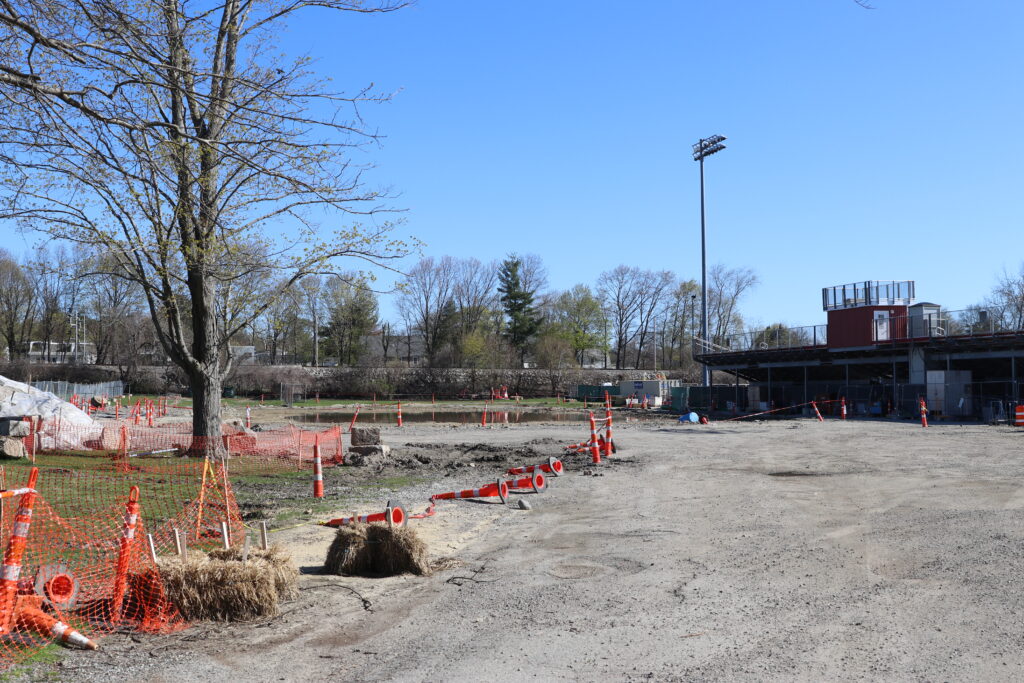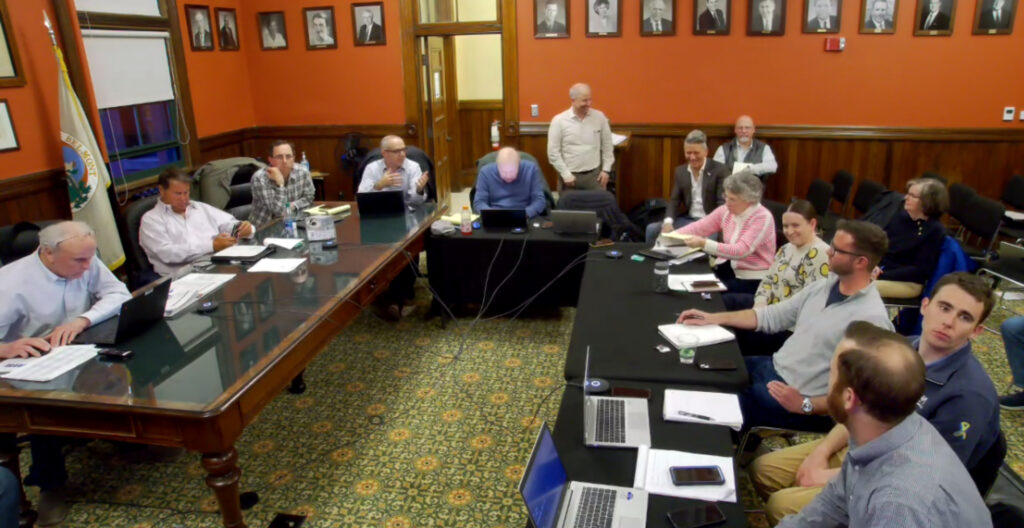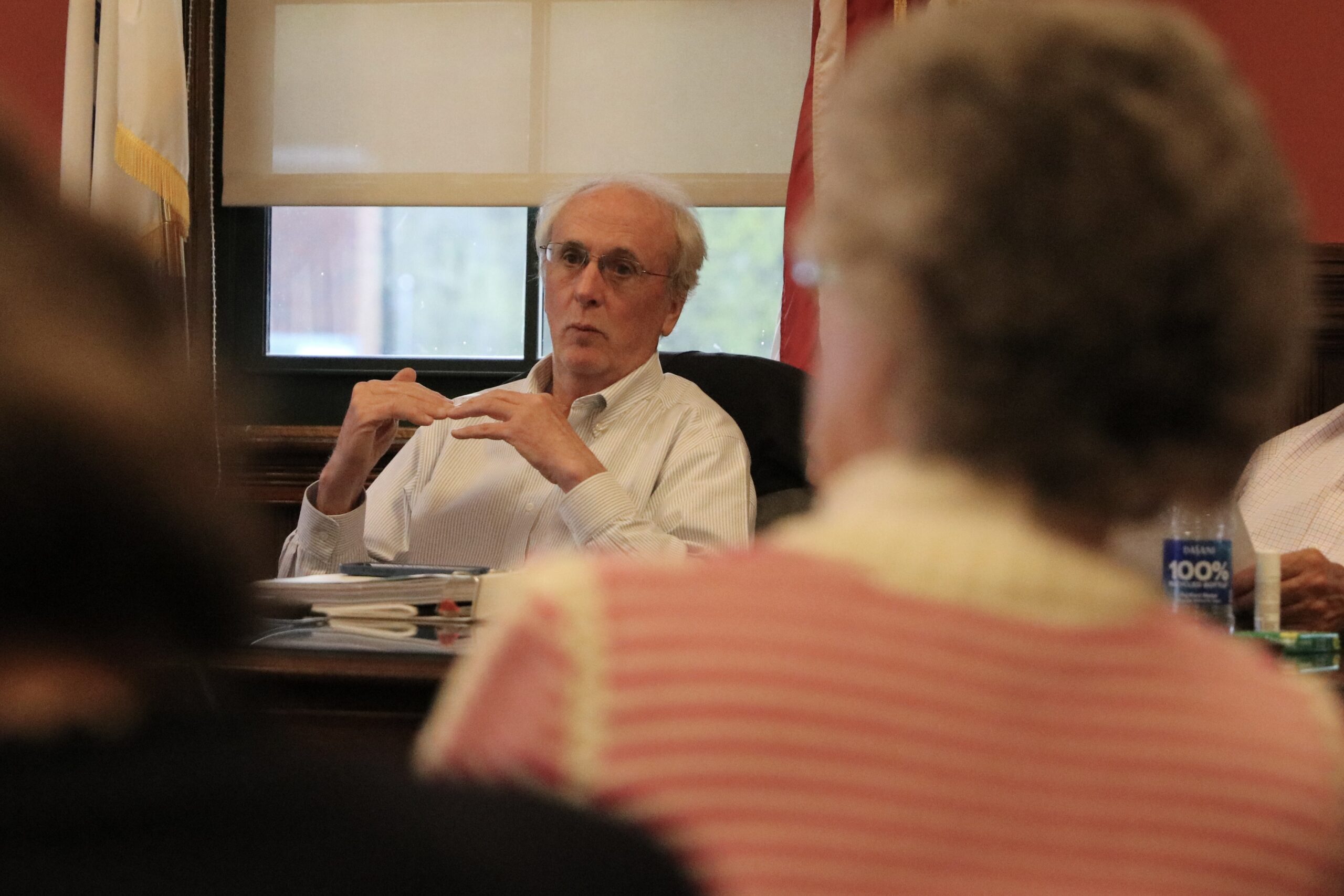Photo: Mark Haley, chair of the Municipal Skating Rink Building Committee, at Wednesday’s meeting
In a stunning admission, the Municipal Skating Rink Building Committee revealed on Wednesday, April 24, that the proposed skating rink/community center located on Concord Avenue is approximately $4.3 million over its $30 million budget, according to committee members, jeopardizing the project’s future.
The news comes just over a year after voters passed a $29.9 million debt exclusion to build a replacement for the dilapidated ‘Skip’ Viglirolo Skating Rink that stood for nearly 50 years at the same site as the new rink.
While the committee, construction contractor Skanska USA, and the owner’s project manager CHA are scrambling to make significant cuts to the project in an attempt to siphon off the red ink threatening the new rink, it appears the committee will come before the annual Town Meeting in late May seeking an infusion of dollars to bridge the shortfall.
“The long and short of it is we have to make some drastic cuts and get that number as close to $30 million as we can,” said Mark Haley, chair of the Municipal Skating Rink Building Committee.
The day before Wednesday’s meeting, Haley and representatives from Stanska and CHA met with town officials, including Town Administrator Patrice Garvin, Select Board Chair Roy Epstein, and Town Moderator Mike Widmer, on the rink’s future. While most of what was discussed remains under wraps, Haley revealed that Epstein – whose board would submit an article before Town Meeting – told him he would not bring a request before members greater than $2 million.
“If we need more money, we have to do it quickly,” said Haley, as the Select Board will need a final number in early May to have a Town Meeting vote later that month. “If we stay at the [current cost], we’re being told there is no project.”
At the end of the first night of value engineering, the committee reduced the deficit to $33.0 million, but only after major reductions to the building’s interior and exterior. This immediately sounded alarms that a reduced building is not what voters – specifically supporters – cast their ballots for.

But when the members reconvened on Thursday morning, April 25, the building team was in better spirits. They believed a compromise solution that secured more reductions without challenging the programming was doable despite giving themselves only four working days before revealing a major budget rewrite on Wednesday, May 1.
The story behind the more than 10 percent cost acceleration in the past year is familiar to any construction project. Haley revealed that due to shortages and supply chain delays, nearly every construction cost has spiked since voters approved the project. Examples included concrete costs up by more than half a million dollars, masonry $400,000, the site package $704,000, and plumbing $306,000. Add inflation to other costs, and the total price tag is currently pegged at $34.3 million.
When Haley asked if there were any questions after revealing the deficit, the Select Board Room turned eerily silent as those in the room – many hearing the amount for the first time – took in the enormity of the shortfall.
When the shock wore off, the brutal reality came into focus. If you want a rink, cutting your way to that goal will be ugly, from fairly insignificant expenses facing the chopping block to ripping out the front lobby and possibly reducing the number of locker rooms from the site.
“I was a big proponent of many of these items and not cutting them, and I’d hate to see some of them go,” said Dante Muzzioli of the Building Committee. “But if it comes down to having a project or not having a project, I’m here to make some tough decisions” during the value engineering process.
Value engineering analyzes building features, systems, equipment, and material selections to achieve essential functions and enhance results while reducing costs.
While Building Committee member Ann Marie Mahoney voiced harsh skepticism of the process -“how you can value engineer $5 million out of $35 million … without so destroying the project that it’ll makes it meaningless.” – Patricia Brusch of the Permanent Building Committee told the room value engineering is not necessarily “a really bad thing. It can make a project much better … and force you to make decisions that gets what you want.”
With 40 years of experience overseeing the construction/redesign of nearly every school in town, as well as the renovation of Town Hall and the building of the Beech Street Senior Center, Brusch said the building committee needs to be diligent in designating what in the project is a “need” (a required element), a “want” (nearly a need that is something that you’d like), or a “nice to have.”
“Everything goes on the table that can go on the table,” she said. “Everybody’s idea is an OK idea to throw on the table, no matter if it’s a sacred cow.”
“It might not be black,” stated Brusch of what the committee was about to start, saying there might be “a little gray” when working with creative people. Listen to what they say and collaborate so the committee can “still salvage what you want. In the end, you’ll have a fabulous sheet of ice in a building that the town is dying to use.”

Intending to reduce the project by $4 million, the committee, architect Ted Galante, and reps from the contractor and project manager spent nearly two hours Wednesday reviewing about two dozen budget items to determine how removing them would impact the project and it bottom line. While many of the reductions were in the five figures, the most significant cut was deferring the installation of the PV solar panels to a future date, thus reducing expenses by $1,305,000. One item surviving the process was a series of large windows along the east and west walls.
However, as the total reductions remained far removed from the $4 million target, the suggested reductions became more consequential, such as removing the building’s lobby, thus radically altering the building’s appearance to where it will represent a “gray aluminum box.” Some discussions were advanced to just order the pre-engineered building and “plop” it on the site, only to be rejected.
“There is no design, there is no aesthetic, and there is nothing that the community voted for here except the ice,” said Mahoney. Committee member Tom Caputo reiterated Mahoney’s observation, saying the cuts could be so drastic that they reduce or eliminate programs – such as using the building for summer recreation or the expected locker rooms for high school sports teams – alienating rink supporters.
When a proposal to reduce the three-season locker rooms from four to two was presented, Muzzioli said, “[t]hat is not what we promised the school department or anyone else. We took the White Field House down and said we would provide locker space.”
Committee member Anthony Ferrante said the package should be presented to the public once the recommended reductions are finalized.
“We have to go back to the town and say, ‘This is what we’re planning.’ ‘This is how we got here,” Ferrante said.
When the meeting reconvened on Thursday morning, overnight alterations by Skanska’s designers, including lowering the roof element, revisioning the lobby and building front, and repositioning the rink closer to Concord Avenue to reduce the building’s footprint and volume, gave the group added momentum on finding the right combination of cuts and alterations.
“I do think a few ideas have been tossed out [Thursday] that don’t compromise the program and in some way represent cost savings that preserve or bring back [elements] that last night we were talking about disappearing,” said Caputo.
Given their marching orders, the committee will meet on Wednesday, May 1, at 7:30 a.m., with a complete list of cuts and their savings. Haley said he and Mahoney would meet early next week with town officials “to discuss finding more money.” One possible funding source a member threw out during the meeting is the town account created from the Kendall School fire settlement funds.








Leave a Review or Comment